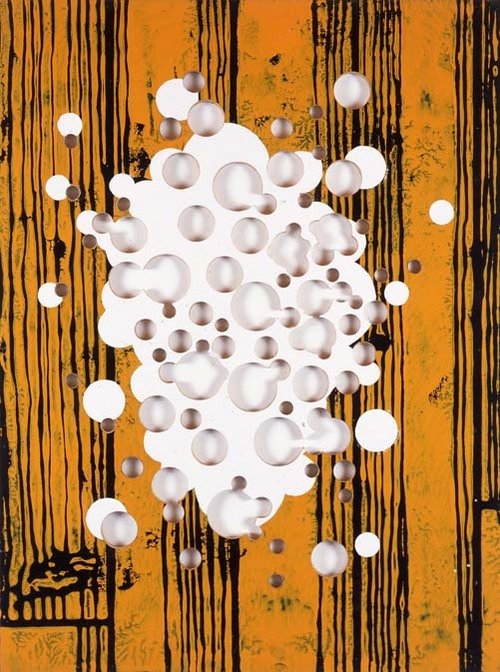Ball the Wall
dal 21/11/2006 al 6/1/2007
Segnalato da
21/11/2006
Ball the Wall
David Risley Gallery, London
Richard Woods presents images of wallpaper and wood grain bigged up, both in size and in visceralness. James Hyde works the material means of the ordinary, presenting boxes of plate glass. Stephen Dean has used familiar objects in the past to make his painterly objects.

Stephen Dean, James Hyde, Richard Woods.
The ordinary changes fast. Hunkered between Utopia and Nostalgia, the commonplace
is both imperative and model for Stephen Dean, James Hyde and Richard Woods. In
this show Woods presents images of wallpaper and wood grain bigged up, both in size
and in visceralness. Woods renders his patterns in viscous gloss paint. Hyde works
the material means of the ordinary, presenting boxes of plate glass, the basic
construction unit of the modernist curtain wall, containing oil paint-- that most
ordinary of art materials. Dean has used familiar objects (stacked paperback books
and modified ladders) in the past to make his painterly objects. In this show it's
barroom dart boards, scrambled to make vertiginous dials.
Ordinary artists? Yes, but the ordinary transformed... into art which is, when
presented in an art gallery, well - ordinary. The ordinary is the cover, the
politic of these artists' works. A counterexample. When the ordinary is presented
as untransformed in a gallery it becomes exotic and it is a narrative or the
institutional frame that houses the significance. It may be that old time modernist
immanence-of-the-art-object, but these works fiercely define their own frame. As
Dean, Hyde and Woods hunt the ordinary and gather it up into their art works the
ordinary is defined, enshrined and renovated. The ordinary changes fast. It is
this dynamic of transformation with it's attendant physical effects of image,
material and object... and equally hand, pattern and texture that is a source of
(infectious) delight for Dean, Hyde and Woods. In an anthropological sense this is
how to turn the ordinary into a place of commonality.
All the works in this show are wall works. They take the place of painting, but not
it's good, traditional form, (these are not properly, or properly badly, rendered
oil on canvases). Conventional painting expects the wall to disappear as the
painting's fantasies are consumed, but with the dartboards (Dean), transparent boxes
(Hyde) and wallpaper patterns (Woods) the wall is essential to bounce against. More
than a support it's a field of possibilities. The title Ball the Wall comes from a
song the New Orleans pianist and singer Professor Longhair wrote in the 1950's. The
phrase probably refers to dancing to or up the wall, but it has other connotations--
sex, gaming or smacking up against a limit and though certainly not an intended
meaning of Professor Longhair's exuberant song, abject weeping.
Dean, Hyde and Woods are friends who have been eyeing each other's work over the
past decade. This show is bound to reveal some fairly compelling affinities and
distinctions. Stephen Dean, originally from Paris, James Hyde from western New York
State and Richard Woods who grew up in Northern England have different cultural and
social maps, but share a commitment to an embodied physic in their art-making.
Woods recently created a house sized exterior installation at Wimbledon college,
Hyde recently created a commissioned intervention of luminous furniture at the San
Diego Museum of Art and Dean is currently exhibiting at the critically acclaimed
Santa Fe Biennial.
Private view Wednesday 22 November
David Risley Gallery
45 Vyner Street - London



